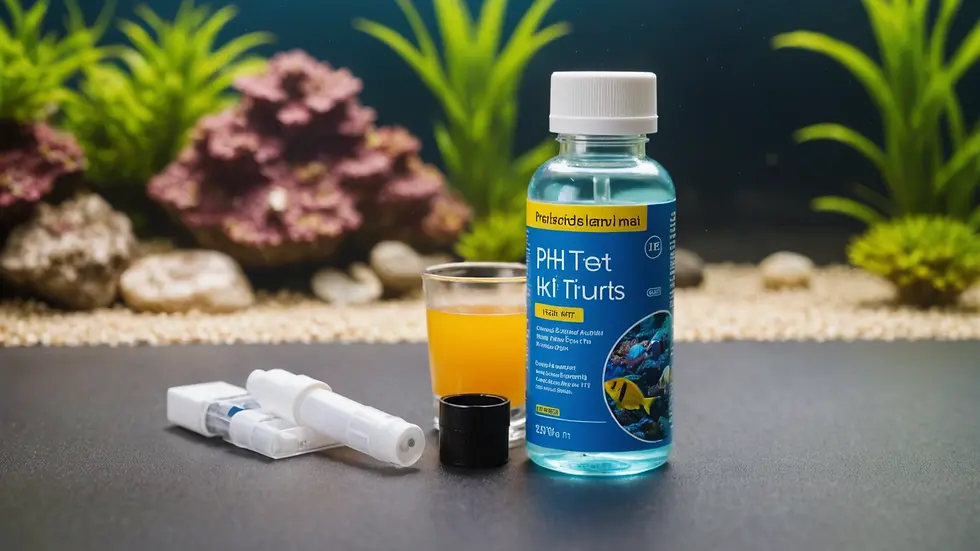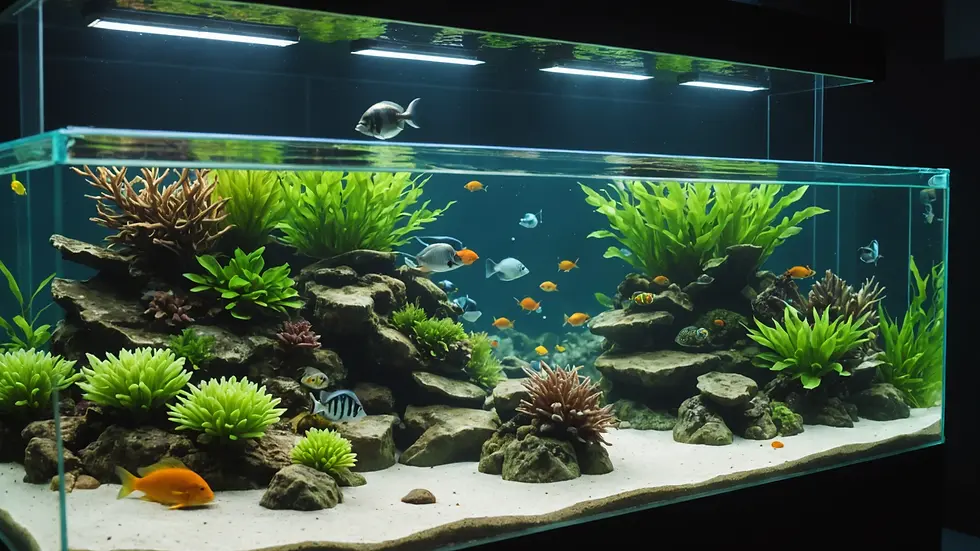Balancing Act: Tips for Keeping Your Aquarium's pH Levels in the Goldilocks Zone
- Jyotiraj Borah
- Feb 6
- 5 min read
Maintaining an aquarium comes with incredible joy as you observe colorful fish and lush plants. However, one critical aspect can become a challenge: the pH levels. Just like Goldilocks searching for the right porridge, finding the perfect pH is essential for a thriving aquatic environment. An unsuitable pH can lead to stress, illness, and even death for your beloved fish. This guide provides essential insights into understanding, monitoring, and adjusting pH levels in your aquarium, ensuring a healthy home for your aquatic life.
Understanding pH and Its Importance
pH measures how acidic or alkaline water is, ranging from 0 to 14. A pH of 7 is neutral, while numbers below indicate acidity and those above indicate alkalinity. Most freshwater fish thrive between a pH of 6.5 and 7.5, but specific species may need different levels. For example, Tetras prefer slightly acidic conditions, around pH 6.0 to 6.8, while African Cichlids thrive in more alkaline waters, typically between pH 7.8 and 8.6.
Maintaining the right pH level is critical for fish health and the overall water chemistry. It significantly influences beneficial bacteria growth, toxic substances like ammonia and nitrites, and the general balance within your aquarium ecosystem.
The pH Scale and Its Implications
Understanding the pH scale is essential. Each increment or decrement on this scale represents a tenfold change in acidity or alkalinity. For instance, a pH of 6 is ten times more acidic than 7 and a hundred times more acidic than 8. Just a small change in pH can create a significant impact.

Moreover, sudden fluctuations in pH can cause stress in fish. Signs of stress may include erratic swimming, loss of appetite, or faded colors. Regular monitoring and adjustments are essential for maintaining a stable environment.
Common Causes of pH Variability
Several factors can lead to fluctuations in your aquarium's pH levels. Recognizing these can help you maintain stability.
Tap Water Chemistry: Water quality varies greatly by location. For instance, tap water in some areas may have a pH of 8.0, while in others it could be as low as 6.2. Always test your water source before adding it to your aquarium.
Fish Waste: Fish excrete waste that can accumulate organic acids over time, lowering the pH.
Uneaten Food and Decomposition: Leftover food and decaying matter produce acids that can contribute to pH changes.
Substrate and Decorations: Certain materials, such as limestone or coral, can increase pH levels by leaching calcium into the water.
Carbon Dioxide Levels: Elevated carbon dioxide can decrease pH, particularly in heavily planted tanks where the plants consume oxygen and produce CO2.
By pinpointing these variables, you can take proactive steps to keep your aquarium's pH levels steady.
Monitoring pH Levels
Consistently monitoring your aquarium's pH is essential for any hobbyist. Consider these approaches:
Using pH Test Kits
You can choose between liquid test kits and digital meters. Liquid test kits are affordable and involve mixing a water sample with reagents to visually determine the pH level. A digital meter provides immediate, precise readings, though it comes at a higher cost.
Regardless of which method you choose, make testing part of your routine. Aim to check pH levels weekly or bi-weekly, or immediately following major changes in the aquarium, such as adding new fish or altering the water.
Observing Fish Behavior
Fish behavior can often signal pH issues. Signs of stress include gasping for air, excessive hiding, or unusual aggression. While observing can indicate problems, it should not replace regular water testing.
Alkalinity’s Role in pH Stability
Alkalinity, or buffering capacity, is critical in maintaining stable pH levels. High alkalinity can resist temporary changes caused by waste products or leftover food, helping to keep the pH consistent. Testing for alkalinity provides valuable insight into your water's buffering ability.
Adjusting pH Levels
If testing reveals pH levels needing adjustment, proceed cautiously. Rapid changes can shock fish, leading to stress or even fatalities.
Raising pH
Add Baking Soda: Dissolving small amounts of baking soda (sodium bicarbonate) into aquarium water gradually raises pH. Check water quality after each addition to ensure stability.
Change Water Source: If tap water has low pH, consider using reverse osmosis (RO) water to reach desired levels.
Calcium-Based Substrates: Crushed coral can raise pH naturally over time as it dissolves, releasing calcium into the water.
Lowering pH
Peat Moss: Adding peat moss to your filtration system releases tannins that can gradually decrease pH.
CO2 Injection: For planted tanks, introducing carbon dioxide at controlled levels can reduce pH effectively, benefiting plant growth.
Water Changes with Rainwater: Rainwater is usually more acidic, making it an excellent option for gradual pH reduction.
Chemical Solutions: There are commercial products designed to adjust pH, but always follow usage instructions carefully and apply changes gradually.
Importance of Slow Adjustments
Making gradual adjustments is vital for the health of your fish. Sudden changes can lead to severe stress. Aim to adjust pH levels by no more than 0.2 to 0.5 units per day, allowing your tank’s biological systems to adapt comfortably.
Maintaining pH Stability
Once you’ve achieved your target pH, maintaining stability requires dedication.
Routine Maintenance
Setting up a regular maintenance schedule is essential. Perform regular water changes to dilute waste and reset potential pH impacts. A 10-15% water change every week can significantly improve water quality.
Acclimating New Fish
Taking time to acclimate new fish is important. Gradually introduce them to the tank environment over several hours to prevent shock. This helps reduce stress and survival rates.
Avoid Overcrowding
Overcrowding increases waste and can lead to water quality issues, impacting pH levels. Follow recommended stocking levels based on your tank size and fish species to maintain balance.

Consulting with Experts
If pH problems persist despite your efforts, consult with an aquarium expert or local fish store. They can provide tailored insights, treatments, and advice specific to your aquarium setup.
Finding Balance in Your Aquarium Ecosystem
Achieving and maintaining the ideal pH levels can be a balancing act that requires knowledge, patience, and commitment. By following the strategies outlined in this guide, you can create a flourishing environment where fish and plants thrive.
The Role of Live Plants
Incorporating live plants into your aquarium leads to a more natural setup. Besides producing oxygen, they help stabilize pH by absorbing carbon dioxide and competing with algae. For instance, Java Fern and Amazon Sword plants not only beautify your tank but also improve overall water quality.
Maintaining Stable Temperature
Temperature impacts pH, so it is essential to check and maintain optimal levels. Warmer water holds less oxygen and can lead to pH drops. Ensure that your tank's temperature aligns with the needs of your specific fish species.

Keeping Your Aquarium Healthy and Vibrant
Ensuring the correct pH levels in your aquarium is crucial for a vibrant and healthy aquatic environment. By understanding the elements that influence pH, consistently testing water conditions, and implementing gradual changes, you can create an environment where your fish will flourish.
Adopt a balanced approach that involves monitoring, adjusting, and maintaining optimal conditions. Every aquarium is unique, so remain attentive and adaptable to your setup's needs. Embrace the beauty of your underwater world, and watch as it thrives.




Σχόλια